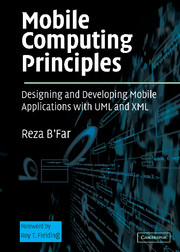Book contents
- Frontmatter
- Contents
- Foreword by Roy T. Fielding
- Acknowledgments
- SECTION 1 INTRODUCTIONS TO THE MAIN TOPICS
- SECTION 2 DEVICE-INDEPENDENT AND MULTICHANNEL USER INTERFACE DEVELOPMENT USING UML
- SECTION 3 ADDITIONAL DIMENSIONS OF MOBILE APPLICATION DEVELOPMENT
- SECTION 4 PUTTING THE PROJECT TOGETHER
- Chapter 15 The Mobile Development Process
- Chapter 16 Architecture, Design, and Technology Selection for Mobile Applications
- Chapter 17 Mobile Application Development Hurdles
- Chapter 18 Testing Mobile Applications
- Chapter 19 A Case Study
- References
- Index
Chapter 16 - Architecture, Design, and Technology Selection for Mobile Applications
from SECTION 4 - PUTTING THE PROJECT TOGETHER
Published online by Cambridge University Press: 03 September 2009
- Frontmatter
- Contents
- Foreword by Roy T. Fielding
- Acknowledgments
- SECTION 1 INTRODUCTIONS TO THE MAIN TOPICS
- SECTION 2 DEVICE-INDEPENDENT AND MULTICHANNEL USER INTERFACE DEVELOPMENT USING UML
- SECTION 3 ADDITIONAL DIMENSIONS OF MOBILE APPLICATION DEVELOPMENT
- SECTION 4 PUTTING THE PROJECT TOGETHER
- Chapter 15 The Mobile Development Process
- Chapter 16 Architecture, Design, and Technology Selection for Mobile Applications
- Chapter 17 Mobile Application Development Hurdles
- Chapter 18 Testing Mobile Applications
- Chapter 19 A Case Study
- References
- Index
Summary
We're gonna be rich!
Jos Bergmans (in 1999 while holding shares of AdForce, in which he would not be vested until after the company's demise during the post-Internet boom)
INTRODUCTION
Much of what we have discussed in this text has been focused on design problems and high-level approaches to building mobile applications. We have intentionally stayed away from a more syntactical-driven approach because languages and tools are evolving rapidly in the space of mobile applications. We have looked at a variety of design patterns and architectural solutions that address the problems associated with mobile applications. In this chapter, we are going to take a step back, look at some very high level architectures, and discuss how we should use them in building our mobile applications.
In an abstract manner, a software system is to the domain problem it solves what the solution may be to a math problem. Through the years, mathematicians have refined “canonical” solutions to a wide variety of mathematical problems. “Canonical,” as defined by the Webster dictionary, is an adjective for something “conforming to a general rule or acceptable procedure.” Much of the purpose of various fields of engineering is to define these canonical “best practices and ways” of doing things for given problems. A large part of the field of software engineering involves defining canonical solutions for developing software applications so that every problem in building a software application does not have to be solved from scratch.
- Type
- Chapter
- Information
- Mobile Computing PrinciplesDesigning and Developing Mobile Applications with UML and XML, pp. 773 - 787Publisher: Cambridge University PressPrint publication year: 2004



